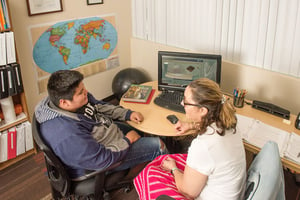The physical learning environment makes a difference in the student’s ability to focus and learn....
IEP vs. 504
When a student begins struggling in school, there are several options available to parents, and this blog will attempt to sort out the differences. It's always worthwhile to start a conversation with the teacher, as the teacher is uniquely positioned to make adjustments within the classroom and may be able to provide additional information that helps support the student. Just having an open dialog often resolves situational setbacks.
Two Significant Options for Support
But sometimes the student needs deeper support or has an issue that merits ongoing accommodation or specially-designed instruction. In these cases, there are two legal paths to consider: Individuals with Disabilities Education Act (IDEA) and Section 504 of the Americans with Disabilities Act. IDEA is commonly called special education and applies to public schools, who must provide a free appropriate public education to all students. This act requires that schools develop an Individualized Education Plan, or IEP, for each student who qualifies for these additional services.
The Americans with Disabilities Act is not specific to education and applies to all settings, including both public and private schools as well as employers once the student enters the workforce after graduation. Under ADA, schools develop a 504 Plan, which lists accommodations that students require to access instruction when they have a condition that "significantly limits major life activities," one of which is learning.
Equalizing Access to Instruction vs. Customizing a Learning Plan
At a big picture level, the primary difference between a 504 and IEP is that the 504 Plan is designed to equalize access to the same instruction as peers without disabilities. A 504 Plan is constructed primarily of accommodations that a student needs to offset symptoms of their condition, such as extra time to complete an assignment when the student has processing issues, or seating in a quiet and orderly location when the student has attention issues and is easily distracted. By contrast, an IEP is a fully-customized learning plan that outlines an appropriate education program for the student. An IEP may include components such as specially-designed instruction, a teacher with unique skills or specific training, and a physical environment designed to address physical, learning, and attention needs of the child.
It is important to note that neither an IEP or 504 is limited to learning issues. A student who is very capable cognitively may still have a physical condition or mental illness that impacts a student's ability to attend school or to process information while in the classroom, and requires one of these interventions to provide an appropriate education to the student.
Because an IEP may also include accommodations that might appear in a 504 Plan, there can be confusion about the differences between the two and under which circumstances each is beneficial. Below is a chart comparing some of the differences.
|
504 |
IEP/Special Ed |
|
|
Staff |
No additional staffing expense |
Special needs qualified teachers and staff in separate classrooms |
|
Content |
Adjust the volume, deadlines, approach but still cover all content |
Modified course content |
|
Eligibility |
Team determines when student has a condition that impacts a major life activity (learning) |
Must meet testing requirements |
|
Classmates |
General population |
Special education students |
|
Renewal |
No firm expiration or re-evaluation term. Generally reviewed annually |
Must be reviewed annually with a re-evaluation conducted every 3 years |
|
Length |
Lifelong accommodations, including college and workplace |
Until graduation or age 21 |
|
Transcript |
Standard course titles with no indication of 504 accommodations |
Often includes a modified grade or course title |
The IEP Process
The IEP offers greater flexibility and personalization, but also has specific requirements to gain eligibility. The IEP brings additional funding to the school, so decisions should be based on what each child needs rather than resources available within the building. Parents play an active role in the development of an IEP, and can always request an additional IEP meeting any time they believe their child's needs have changed or aren't currently being met.
If unable to resolve the concerns through the team at the school level, there is a defined process allowing the parent to accelerate the case to include district involvement, and ultimately to file for due process so that a judge or mediator determines the appropriate placement and services. There are many steps to this process, so families are often served to consult with an attorney specializing in special education so that they are familiar with their child's rights, and also with the technical requirements of the process, which in turn can affect the options available to the family. There are very specific timelines included within the law, so the family must give the district a chance to respond, and the district must also be timely in their response. Understanding these parameters can help reduce stress and misunderstandings on both sides.
Support within Private Schools
Private schools do not fall under IDEA as they are created to fulfill their mission, which in some cases does include special education services. The Americans with Disabilities Act is not specific to education and applies to all settings, including both public and private schools as well as employers once the student enters the workforce after graduation. Private schools often do offer customized written learning plans that outline how a special needs student will receive accommodations within their environment, and this can be part of the admissions process when determining whether or not the student and private school will be a good fit.
Brightmont Academy is a private school that serves all students using a one-to-one instructional approach, so all aspects of an educational program can be customized. This flexibility enables a partnership with public school districts in those rare cases when a student might otherwise be unable to attend school regularly, or needs the one-to-one model to benefit from instruction. As the student becomes healthier, they can integrate back into a traditional classroom using a gradual process designed not to overwhelm the student, or the student can graduate from Brightmont Academy.
Resources to Advocate for your Child
When an IEP or 504 should be implemented for an individual student and what the contents of each document should be is, by definition, determined on a case-by-case basis. We can never forget that the "I" part of the IEP is for Individual, and must be customized for each unique student's needs. Parents who have questions are always encouraged to talk with their school administration, or to seek information from a child advocate or an attorney specializing in special education law. Working with an attorney doesn't have to mean that they attend meetings and that conversations become confrontations; many families have experienced success just by getting the guidance they needed behind the scenes and the language to advocate appropriately on behalf of their child.
References:
Protecting Students With Disabilities - US Department of Education




